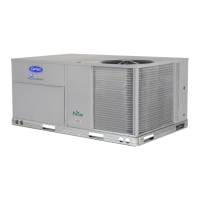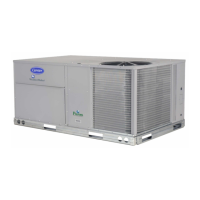148
Fig. 35 — VFD Wiring
Table 116 — VFD Terminal Designations
VFD POWER EXHAUST
On units equipped with VFD power exhaust, both power ex-
haust fan motors are controlled by a single VFD. Fans are
turned on by the ComfortLink controls based on building pres-
sure sensed by the building pressure transducer. The VFD fan
speed is controlled by the ComfortLink controls. The power
exhaust fan motors are each protected by a motor starter pro-
tector located in an enclosure below the power exhaust VFD.
The required motor starter protector settings are shown on a la-
bel on the cover of the enclosure.
HIGH CAPACITY POWER EXHAUST (SIZES 075-100
ONLY)
The power exhaust fans are two belt-driven forward-curved fans.
Operation of the power exhaust is a combination modulating/
staged control. The lead fan is controlled by a VFD and provides
0 to 50% of total exhaust capability. The second fan is staged
On/Off (for a step of 50% of total exhaust capability) according
to the VFD output level on fan no. 1.
RETURN FAN (SIZES 075-100 ONLY)
The return fan power exhaust assembly consists of one belt-
drive plenum fan. The plenum fan pressurizes the plenum fan
section so that the air can either be discharged horizontally out
the back of the unit or discharged through the return air section
of the economizer.
ECONOMIZER MOTOR(S)
The economizer outside air and return air dampers are gear-
driven dampers without linkages. A communicating economiz-
er motor(s) controls their position. The motor position is con-
trolled by the MBB through the communication bus. This al-
lows for accurate control of the motors as well as feedback in-
formation and diagnostics information. The control has a self-
calibration routine that allows the motor position to be config-
ured at initial unit start-up. The motor(s) is located on the econ-
omizer and can be reached through the filter access door.
THERMISTORS AND PRESSURE TRANSDUCERS
The unit is equipped with several thermistors for measurement
of temperatures. The thermistors are summarized in Table 117.
The units have two pressure transducers that are connected to
the low side of the system. These two pressure transducers
measure the low side pressure and are used for low pressure
protection and coil freeze protection.
The units also have two pressure transducers that are connected
to the high side of the system. These two pressure transducers
measure the discharge pressure and are used to cycle the con-
denser fans to maintain head pressure.
By using the high and low side pressure transducers, the Com-
fortLink controls display the high and low side pressures and
saturation temperatures and a normal gage set is not required.
SMOKE DETECTOR
The units can be equipped with an optional smoke detector lo-
cated in either the return air or supply air, or in both. The detec-
tor is wired to the ComfortLink controls and, if activated, will
stop the unit by means of a special fire mode. The smoke detec-
tor can also be wired to an external alarm system through TB201
terminals 1 and 2. The sensor is located in the air section.
FILTER STATUS SWITCH
The units can be equipped with an optional filter status switch.
The switch measures the pressure drop across the filters and
closes when an adjustable pressure set point is exceeded. The
sensor is located in the return air section behind the filter ac-
cess door.
+24 V
GND
DCOM
DI-1
DI-2
DI-3
DI-4
DI-5
DI-6
SCR
B(+)
A(-)
AGND
SCR
10 11 12 13 14 15 16 17 18 28 29 30 31 32
LEN connection from ComfortLink
Terminal X1
TERMINAL FUNCTION
U1 Three-phase main circuit input power supply
V1
W1
U2 Three-Phase AC Output to Motor, 0 V to
Maximum Input Voltage Level
V2
W2
X1-11 (GND) Factory-supplied jumper
X1-12 (D-COM)
X1-10 (+24 V) Factory-supplied jumper
X1-13 (DI-1)
X1-10 (+24 V) Start Enable 1 (Factory-supplied jumper). When
opened the drive goes to emergency stop.
X1-16 (DI-4)
X1-28 (SCR) Factory wired for local equipment network LEN
communication
X1-29 (B+)
X1-30 (B-)
X1-31 (AGND)
X1-32 (SCR)

